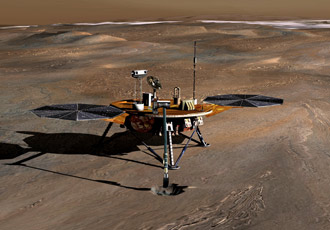- NASA Home
- | Missions
- | Phoenix Mission
- | Spacecraft & Instruments
Spacecraft and Instruments
Overview
Spacecraft
The Phoenix Mission inherits a highly capable spacecraft partially built for the Mars Surveyor Program 2001 and important lessons learned from the Mars Polar Lander. The spacecraft was in an advanced state of development when NASA canceled Mars Surveyor 2001 and has been housed in a Class 100,000 clean high-bay facility at Lockheed Martin Space Systems, Littleton, Colorado.

Image above: Artist's concept of Phoenix. Image credit: NASA/JPL.
+ Full image and caption
The spacecraft will experience extreme conditions during travel to and exploration of Mars. During launch, the spacecraft will undergo tremendous load forces and shaking stresses as the launch vehicle is propelled out of Earth's gravity well. During the 10-month cruise to Mars, the spacecraft must be able to withstand the vacuum of space with potential radiation hazards from solar storms and micro-meteor impacts from interplanetary dust. During entry, descent, and landing, the spacecraft will be heated to thousands of degrees during aeroshell braking, jerked with tremendous force as the parachute is deployed, and finally will come to a soft touchdown using controlled thrusters. Finally, during surface operations, the spacecraft must withstand the extremely cold temperatures of the martian arctic and the dust storms that potentially affect the area.
Designing and constructing a spacecraft to withstand these extremes is a tricky endeavor and requires considerable testing before launch. Benefiting from the lessons learned during the Mars Polar Lander and Mars Surveyor Program 2001 experience, as well as further reliability upgrades and subsystems used in previous successful space missions, the spacecraft is in a high state of development early in the mission's fabrication phase. Therefore, the mission engineering team is working on developing enhanced spacecraft reliability through extensive testing, (i.e., beyond normal integration and environment testing that occurs for most missions).
The spacecraft has several subsystems that are being updated, if necessary, with parts and software that will increase reliability. These subsystems include (1) command and data handling, controlling the spacecraft's computer processing, (2) electrical power, consisting of solar panels, batteries, and associated converting circuits, (3) telecommunications, ensuring flow of data to and from Earth, (4) guidance, navigation, and control, assuring the spacecraft arrives safely at Mars, (5) propulsion, controlling trajectory correction maneuvers during cruise and thrusters during landing, (6) structure, providing the spacecraft framework and integrity, (7) mechanisms, enabling the movement of several spacecraft components, and (8) thermal-control, using heat transfer to ensure proper temperature ranges on all parts of the spacecraft.
Instruments
+ Robotic Arm
+ Robotic Arm Camera
+ Thermal and Evolved Gas Analyzer
+ Mars Descent Imager
+ Meteorological Station
+ Surface Stereo Imager
+ Microscopy, Electrochemistry, and Conductivity Analyzer